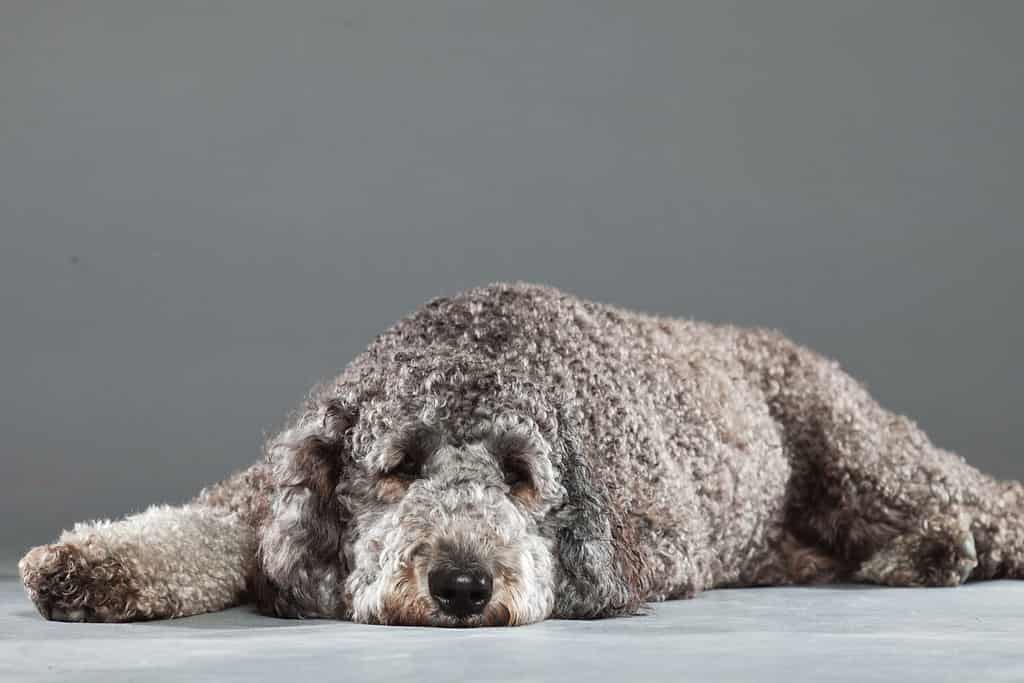Labradoodles and other poodle mixes are becoming especially common, but these “designer breeds” are pretty controversial! Let’s dig into some common labradoodle complaints to find out why.
One of the top labradoodle complaints isn’t about the dogs, but the breeders who breed them unethically. People also complain that they’re unhealthy, require daily grooming, and have a ton of energy. Labradoodles can be expensive to care for as well.
In this article, we’ll discuss common complaints about labradoodles, dispel some myths about this breed mix, and more.
Are Labradoodles Good Dogs?

Labradoodle temperaments can be unpredictable since they’re a mixed breed.
©Samara Abramson – License
Many problems with labradoodles are in regards to their breeding, not the dogs themselves. Even the man who created this breed mix, Wally Conron, has said that he regrets it due to the “designer dog breed” and doodle trend that followed.
Most labradoodle breeders are in it for the money, meaning they don’t care for and breed the dogs properly. For instance, most will not pay for genetic health testing for the parent dogs, which is essential to ensure they aren’t breeding unhealthy pups.
In addition, many will lie about coat maintenance and shedding. Labradoodles often shed plentifully, just like their Labrador ancestors. They also require daily brushing and a trip to the groomer every four to six weeks.
In addition, you’ll encounter a mixture of the problems that Labrador and poodle guardians face. This may include mouthiness, destructive chewing, excessive barking, a sensitive stomach, and more.
If you can find a rescue labradoodle and don’t mind their care requirements and some unpredictability in their traits, they make great pets. Otherwise, we highly recommend looking into ethically-bred Labrador retrievers, standard poodles, or even another breed that’s a better fit!
#1: Many Labradoodles Shed

Many labradoodles inherit their shedding from their Labrador parentage, meaning they shed a lot!
©iStock.com/Oskari Porkka
Unfortunately, breeding a dog with a non-shedding coat isn’t as simple as combining one breed that sheds and one that doesn’t. Labradoodles have unpredictable coats due to their breed mix, and the amount they shed can vary even within the same litter.
Your labradoodle might shed moderately year-round like a Labrador, with heavier shedding seasons in the spring and fall. They might be non-shedding like a poodle, or somewhere in between.
#2: Their Coats Can be Hard to Groom

Their curly coats require constant upkeep.
©iStock.com/LSOphoto
Combining Labrador and poodle coat types often creates a coat that’s even harder to groom than a purebred poodle coat. Most people aren’t prepared for the upkeep required, leading to neglected, matted dogs who are in constant pain. Some dog groomers no longer take on labradoodles due to this issue.
A labradoodle’s coat must be combed down to the skin daily using a technique called line brushing. They should see a professional groomer every four to six weeks unless you cut their fur, bathe them, and cut their nails at home.
#3: They’re High-Energy Dogs

Labradoodles need plenty of exercise each day.
©Josiah Gaulke/Shutterstock.com
A combination of two very high-energy sporting breeds, labradoodles need multiple long, daily walks alongside playtime at home to stay fit and happy. They often become depressed, anxious, or bored when they don’t get enough physical activity.
This can lead to problematic behaviors such as destructive chewing or excessive barking.
#4: Mixed Breeds are Less Predictable

A labradoodle’s coat, temperament, and health are unpredictable compared to purebred dogs.
©mariakbell/ via Getty Images
You don’t really know what you’re getting with a labradoodle puppy. While every dog is an individual, purebred dogs tend to have a more predictable set of traits.
We know to expect Labradors to be mouthy, to love food, and to have lovable, goofy personalities. They shed a lot but require little grooming. We expect poodles to be incredibly intelligent, affectionate, and clingy. They don’t shed, but need daily grooming to maintain a long coat.
Labradoodles will have a mixture of traits from both breeds, and they may not inherit the traits that are important to you.
This unpredictability also applies to health problems, particularly if the breeder doesn’t complete adequate health testing.
#5: They’re Mouthy and Destructive

Labradors have a tendency to overeat, and labradoodles may inherit this trait.
©chrisbrignell/Shutterstock.com
Dog who take after their Labrador parents will be quite mouthy. You’ll need to teach them at a young age to play with toys, not hands or sleeves.
Labradors are also known for their tendency to chew a ton! As retrievers, poodles can also be big chewers–so you’re almost bound to see it in a labradoodle puppy.
There are many reasons for destructive chewing, including teething, anxiety, and not getting enough exercise or mental enrichment.
#6: They Don’t Make Good Guard Dogs

They’re unlikely to guard your family or home from intruders.
©Ysbrand Cosijn/Shutterstock.com
Your labradoodle is more likely to be a good watchdog, barking at things outside, than to actually guard anything. Both parent breeds are known for being stranger-friendly.
Labradoodles also aren’t seen as intimidating by many people, despite their large size. So, they may not act as a deterrent either!
#5: Labradoodles are Unethically Bred

One of the biggest labradoodle complaints is that they’re bred poorly.
©Angeline Dobber/Shutterstock.com
Labradoodles are considered a “designer breed,” which essentially means that they’re a mixed breed that is sold at a high price tag. Most labradoodle breeders are doing so unethically.
There are two types of unethical breeders: puppy mills and backyard breeders. Puppy mills produce puppies en masse without regard to any of the dogs’ well-being.
Backyard breeders are smaller operations, but they still don’t have the care or knowledge to breed responsibly. Many backyard breeders know they’re doing wrong, and many don’t–but either way, the dogs suffer the consequences.
#6: They’re Prone to Health Problems

Labradoodle pups can inherit health conditions from both parent breeds.
©jadimages/Shutterstock.com
One of the biggest problems with labradoodle breeders is that they don’t health test the parent dogs, and often don’t know their dogs’ lineage.
At the very least, breeders should health test both parents and provide CHIC numbers to prove the results. They should never breed dogs who don’t pass the recommended testing or who aren’t up-to-date on health screenings.
Without this testing, their dogs will likely continue to pass down genetic health problems. Most reputable breeders are against mixed breeds like doodles and therefore won’t sell puppies to doodle breeders. This makes it even less likely the parent dogs are healthy and reputably bred.
Some people argue that mixed breed dogs are healthier than purebreds, but this often isn’t the case, especially when comparing them to reputably bred purebred dogs whose parents went through extensive health testing before being bred.
Labradoodles can inherit common health problems from either parent breed. These include:
- Hip and elbow dysplasia
- Bloat
- Eye conditions
- Exercise-induced collapse
- Centronuclear myopathy
- Heart disease
- Sebaceous adenitis
#7: They’re Expensive

Labradoodles have expensive upfront and ongoing costs.
©Angeline Dobber/Shutterstock.com
Lastly, labradoodles are expensive! Puppies from breeders cost much more than most mixed breed dogs, for none of the benefits you would get from adopting a reputably-bred, purebred pup.
Of course, you can forego this cost by adopting from a rescue or shelter instead of a breeder. Breed-specific rescues, such as poodle rescues, might be the best place to find a rescue labradoodle in your area as they often work to rehome mixed breeds as well.
As large dogs, labradoodles are also expensive to feed and vet. Veterinary care may become even more costly if your puppy develops genetic health issues caused by poor breeding.
Lastly, grooming costs are a big complaint about labradoodles since they need to be groomed every four to six weeks. Even if you do everything at home, grooming supplies are still costly!
The photo featured at the top of this post is © Flyby Photography/Shutterstock.com
Ready to discover the top 10 cutest dog breeds in the entire world?
How about the fastest dogs, the largest dogs and those that are -- quite frankly -- just the kindest dogs on the planet? Each day, AZ Animals sends out lists just like this to our thousands of email subscribers. And the best part? It's FREE. Join today by entering your email below.
Thank you for reading! Have some feedback for us? Contact the AZ Animals editorial team.







